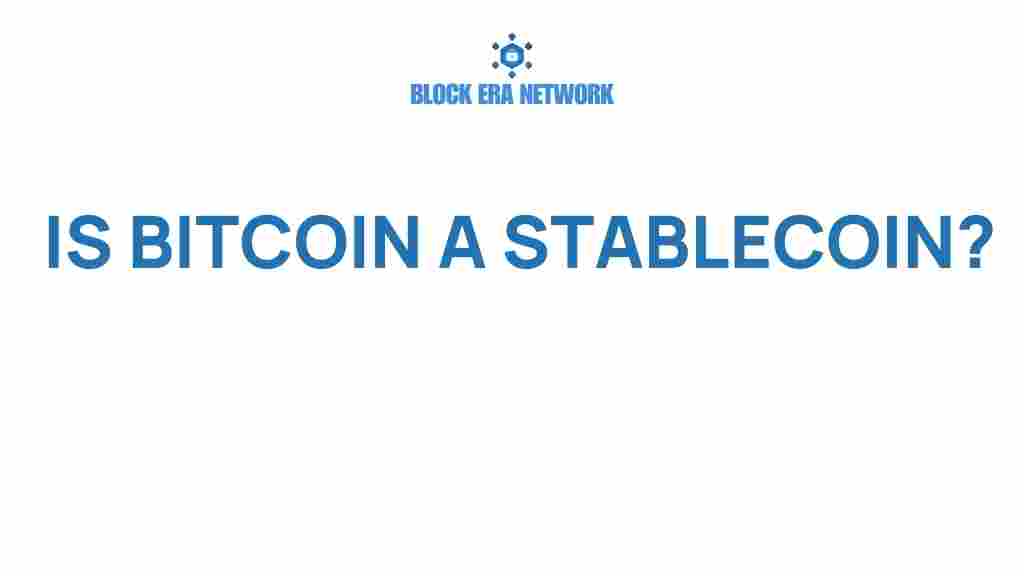Is Bitcoin a Stablecoin? Unraveling the Myths and Realities
In the world of cryptocurrency, few names resonate as strongly as Bitcoin. Launched in 2009 by an anonymous entity known as Satoshi Nakamoto, Bitcoin has paved the way for thousands of other digital currencies. However, a common question among both new and seasoned investors is: “Is Bitcoin a stablecoin?” This article aims to unravel the myths and realities surrounding Bitcoin, its volatility, and its role in the broader landscape of digital assets.
Understanding Bitcoin and Stablecoins
Before we dive deeper, it’s essential to understand what Bitcoin and stablecoins are. Bitcoin is a decentralized digital currency that operates on a technology called blockchain. It is known for its potential to appreciate in value over time but is also infamous for its significant price fluctuations.
On the other hand, stablecoins are a type of cryptocurrency designed to maintain a stable value. They are typically pegged to a reserve asset, such as the US dollar or gold, to minimize volatility. Examples of stablecoins include Tether (USDT), USD Coin (USDC), and DAI.
Bitcoin’s Volatility: A Double-Edged Sword
Bitcoin’s price history is a rollercoaster of highs and lows. Here are some key points regarding its volatility:
- Historical Price Fluctuations: Bitcoin’s price has seen massive surges, such as its rise to nearly $64,000 in April 2021, followed by sharp declines.
- Market Sentiment: Bitcoin’s price can be heavily influenced by news events, regulatory changes, and market sentiment, leading to unpredictable movements.
- Investment Risks: While some investors have made substantial profits, the volatility of Bitcoin also presents significant risks, making it crucial for investors to approach with caution.
Bitcoin vs. Stablecoins: Key Differences
To clarify the distinction between Bitcoin and stablecoins, consider the following:
- Value Stability: Bitcoin’s value can fluctuate wildly, while stablecoins aim to maintain a fixed value.
- Use Cases: Bitcoin is often viewed as a long-term investment or a store of value, while stablecoins are commonly used for transactions and as a bridge to other cryptocurrencies.
- Market Dynamics: Bitcoin’s market dynamics are driven by supply and demand, while stablecoins rely on collateral and reserves to ensure price stability.
The Role of Blockchain in Bitcoin’s Volatility
Blockchain technology is the backbone of Bitcoin and other cryptocurrencies. It is a decentralized ledger that records all transactions across a network of computers. While this technology provides transparency and security, it also contributes to Bitcoin’s volatility:
- Decentralization: The decentralized nature of Bitcoin means that no single entity controls its supply or price, leading to market-driven volatility.
- Mining and Supply: Bitcoin has a capped supply of 21 million coins, and the mining process can create scarcity, influencing price dynamics.
- Transaction Speed: During periods of high demand, transaction speeds can slow down, impacting user experience and market sentiment.
The Investment Perspective
Investing in Bitcoin can be both rewarding and risky. Understanding the market trends and potential for financial security is vital for any investor. Here are some considerations:
Market Trends Affecting Bitcoin
Several market trends can influence Bitcoin’s price and overall stability:
- Institutional Adoption: An increase in institutional investment has led to greater legitimacy for Bitcoin, impacting its price positively.
- Regulatory Developments: Government regulations can significantly affect Bitcoin’s market, either enhancing its credibility or introducing additional risks.
- Technological Advances: Innovations in blockchain technology can enhance Bitcoin’s usability and security, potentially stabilizing its price in the long run.
Financial Security and Bitcoin Investments
Investing in Bitcoin requires careful consideration of financial security. Here are some tips to enhance your investment strategy:
- Conduct Thorough Research: Stay informed about market trends, technological developments, and regulatory changes.
- Diversify Your Portfolio: Don’t put all your funds into Bitcoin; consider other digital assets and stablecoins to balance risk.
- Use Secure Wallets: Protect your investments by using reputable wallets and enabling two-factor authentication.
- Set Clear Investment Goals: Define your investment strategy, whether it’s short-term trading or long-term holding.
Step-by-Step Guide to Investing in Bitcoin
If you’re considering investing in Bitcoin, follow this step-by-step guide:
- Choose a Reputable Exchange: Select a cryptocurrency exchange that offers Bitcoin trading, such as Coinbase or Binance.
- Create an Account: Sign up, verify your identity, and set up your account.
- Deposit Funds: Add funds to your account using bank transfers or credit cards.
- Buy Bitcoin: Navigate to the Bitcoin trading section and place your order.
- Store Your Bitcoin Securely: Transfer your Bitcoin to a secure wallet for safekeeping.
Troubleshooting Common Issues
As with any investment, you may encounter issues while buying or managing Bitcoin. Here are some common problems and solutions:
- Transaction Delays: If your transaction is taking too long, check the network congestion and consider adjusting the transaction fee.
- Account Verification Issues: Ensure that you have submitted all required documents for identity verification.
- Lost Access to Wallet: Always back up your wallet recovery phrase to regain access if you forget your password.
Internal and External Resources
For further reading, you can explore more about the cryptocurrency market trends on this internal link. For comprehensive information on stablecoins, check out this external resource.
Conclusion: The Reality of Bitcoin as a Stablecoin
In summary, Bitcoin is not a stablecoin. Its inherent volatility sets it apart from stablecoins, which are designed to maintain a fixed value. While Bitcoin offers significant investment opportunities, it also comes with risks that investors should not overlook. Understanding the differences between Bitcoin and stablecoins is crucial in making informed decisions in the ever-evolving world of cryptocurrency.
By staying informed about market trends, leveraging blockchain technology, and employing sound investment strategies, you can navigate the complexities of Bitcoin and other digital assets. Whether you view Bitcoin as a long-term investment or a speculative asset, knowledge and caution will serve you well in the quest for financial security.
This article is in the category Cryptocurrency Insights and created by Block Era Network Team
